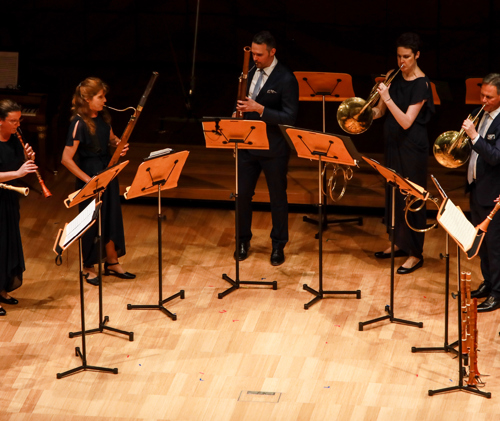From Our Stage
Mozart Harmoniemusik
Harmoniemusik based on the opera
DIE ENTFÜHRUNG AUS DEM SERAIL, K 384 Ouverture

PROGRAM NOTES
Wolfgang Amadeus Mozart (1756–1791)
Aria 'Durch Zärtlichkeit und Schmeicheln'
Aria 'Frisch zum Kampfe! Frisch zum Streite!'
Aria 'Ich baue ganz auf deine Stärke'
Aria 'Ha, wie will ich triumphieren'
In July 1781, after Mozart was literally kicked out of the Prince-Archbishop of Salzburg’s service (with a boot to the backside), he chose to stay in Vienna to try to make his way as a freelance composer and performer. His first opera for Vienna, Die Entführung aus dem Serail (The Abduction from the Seraglio) premiered a year later. It was a huge success, with forty performances. The plot centred around the rescue of a virtuous European woman from a supposed fate worse than death in a Turkish harem, and the exoticism of the story and Mozart’s ‘Turkish’ music struck a chord with popular taste. In his letters to his father, Mozart mentions "the loud shouts of Bravo! during the arias", and that "people are quite crazy about the opera – it really feels good to have this kind of applause".
It was about Die Entführung that the Emperor Joseph II was famously alleged by Mozart’s first biographer to have said, "too beautiful for our ears, my dear Mozart, and vastly too many notes". Mozart is supposed to have replied, "just as many as are necessary, your Majesty".
Four days after the premiere, Mozart wrote to his father:
![]()
[...] it is no small task that lies ahead of me now, for by Sunday week I must have set my opera for Harmonie – otherwise someone else will beat me to it and get the profits instead of me. I have also to make a new symphony – how will that be possible! – you cannot believe how difficult it is to set a work like this for Harmonie, so that it will fit the wind instruments and at the same time, not lose its effect.
From about the middle of the mid-eighteenth century it had been customary for aristocrats to employ a small band of wind players, known as a Harmonie, to provide background music at dinner or outdoors. If the players were servants or regimental musicians, as was often the case, the quality of playing was not high, but in 1782 Emperor Joseph II started his own Harmonie with eight of the best wind players in Vienna. This not only immediately raised the standard but led to the formation of similar professional bands in Vienna and elsewhere, as having one’s own Harmonie became instantly fashionable.
New music was required for them, hence Mozart’s haste to cash in on this lucrative market. The vast majority of this Harmoniemusik was arrangements of operas, ballets and later on symphonies, such that by the 1830s about 10,000 titles had been published, almost all theatre music, and most of this was arranged not by the original composers but by the players themselves. The arrangements aimed to give as much of the effect of the original piece as possible, however in an era when there were no recordings and the notion of copyright was still to be fully developed, the arranger was not under any requirement to conform to the composer’s intentions.
Composers wrote some original Harmoniemusik which was not an arrangement of something else. Mozart re-used popular tunes from his own opera The Marriage of Figaro as well as some by other well known Viennese composers for one of the best-known pieces of Harmoniemusik: the music which accompanies the dinner in the last act of Don Giovanni.
Two weeks after the date of his letter, Mozart sent his father the new symphony he had promised to compose (the Haffner, K 385). On the same day, a Viennese impresario advertised a public performance of "the recently arranged Harmoniemusik from Herr Kapellmeister Mozart’s new opera", but did not give the arranger’s name. No record of the existence of such a work was known until 1983, when a score was discovered at Donaueschingen in Germany. Although the evidence is not conclusive, this appears to be by Mozart, and is the score which the Australian Brandenburg Orchestra will use in this concert series.
WHAT TO LISTEN FOR
By Mozart’s time, a Harmonie usually consisted of eight players, two each of oboes, clarinets, horns, and bassoons, and this score is for those instruments. It is in sixteen movements, although only five will be performed in this concert series: the Overture and four other movements based on arias sung by different characters. We have Mozart’s own comments about two of them, from a letter to his father written while he was working on the opera. The overture, he wrote, "is very short with alternate fortes and pianos, the Turkish music always coming in at the fortes".
The last of the five movements performed in this concert is based on an aria sung by the comic character Osmin, the guard of the harem. According to Mozart, "Osmin’s rage is rendered comical by the accompaniment of the Turkish music … for just as a man in such a towering rage oversteps all the bounds … and completely forgets himself, so must the music forget itself too".
Program Notes: © Lynne Murray, 2017
Image Credit: Steven Godbee, 2017
Listen
{% error.message %}
More for you...
{% series.name %}
Featured Content
{% series.featuredTitle %}




